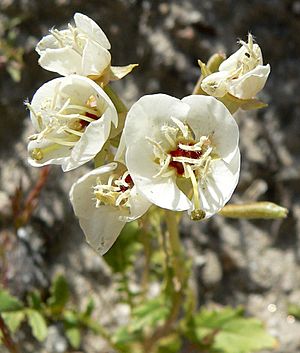Chylismia claviformis facts for kids
Quick facts for kids Chylismia claviformis |
|
|---|---|
 |
|
| Scientific classification | |
| Genus: |
Chylismia
|
| Species: |
claviformis
|
| Synonyms | |
|
|
Chylismia claviformis is a type of wild flower often called browneyes or brown-eyed primrose. It's an annual plant, meaning it grows, flowers, and dies within one year. This plant starts with a cluster of long, oval leaves close to the ground. From this base, it sends up stems that can grow taller than half a meter.
At the top of these stems, you'll find one or many primrose-like flowers. Each flower has four petals, which can be white or yellow. The central part of the flower, called the pistil, can be quite long. It has a rounded tip. The parts that produce pollen, called stamens, are a bit shorter. They have fuzzy tips that hold white or yellow pollen. The base of the flower, where the male and female parts meet, is a bright red, maroon, or brown color. This is where the name "browneyes" comes from! You can find this plant across western North America, from the Pacific Northwest down to northern Mexico.
What Are the Different Kinds of Browneyes?
There are many different types, or subspecies, of Chylismia claviformis. These different types often grow in specific areas. Here are some of them:
- C. c. ssp. aurantiaca – This type is found in desert regions.
- C. c. ssp. claviformis – This one grows in the Mojave Desert and nearby places.
- C. c. ssp. cruciformis – You can find this type in the Great Basin area.
- C. c. ssp. funerea – This subspecies also lives in the Mojave Desert.
- C. c. ssp. integrior
- C. c. ssp. lancifolia – Also known as lanceleaf browneyes, it grows in California, east of the Sierra Nevada.
- C. c. ssp. peeblesii – Called Peebles' browneyes, it's found in Arizona and New Mexico.
- C. c. ssp. peirsonii – Known as Peirson's browneyes, it's native to Southern California and northern Baja California.
- C. c. ssp. rubescens – This type is native to Arizona.
- C. c. ssp. wigginsii
- C. c. ssp. yumae – Also called Yuma browneyes, it grows in the Sonoran Desert.

